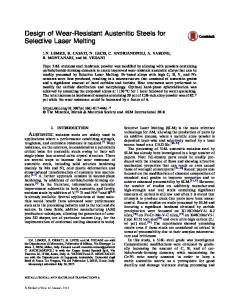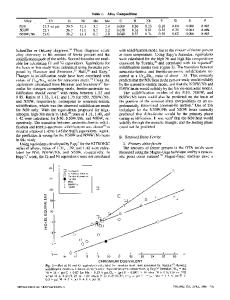Sliding wear of austenitic and austenitic-ferritic stainless steels
- PDF / 2,849,694 Bytes
- 12 Pages / 612 x 792 pts (letter) Page_size
- 104 Downloads / 375 Views
I. INTRODUCTION
IT is now well established that surface plastic deformation plays an important role in determining the sliding wear behavior of metals. Rigney et al.[1] proposed a wear mechanism based on the attainment of large plastic strains at the regions of contact and the formation of debris because of shear instability, transfer, and mixing. The debris produced by both mated materials, and eventually oxidized because of environmental contamination, successively produce a tribological layer, and loose debris is, thus, derived from the fracture of such surface layer. From the pioneering works of Rigney and coworkers, mainly regarding copper alloys, several investigations were carried out, considering different tribological systems, including aluminum and aluminum alloys,[2,3] aluminum-based metal matrix composites,[4,5] titanium alloys,[6] and austenitic stainless steel.[7] All the experimental observations confirm the basic wear sequence proposed by Rigney and co-workers, although many contributions to refine the approach have been given. An intriguing role in the wear process is played by surface oxidation. If the flash temperature is particularly high, direct oxidation of the contacting asperities may take place. In steels, for example, this occurs for flash temperatures higher than about 400 ⬚C and, thus, at sliding velocities higher than, say, 1 m/s.[8] In this case, the sliding wear is by oxidation, and it is described by the Quinn theory.[9] At lower sliding velocities, such oxidation effects are absent, and the sliding wear process is plasticity-dominated, as outlined previously. Surface oxidation, however, may still play a role. In certain conditions, in fact, the metallic debris can oxidize, and the oxidized fragments can agglomerate to form protective scales.[10,11] In most cases, the attainment of this form of oxidative wear is desirable, since wear rate is reduced.[11]
G. STRAFFELINI and A. MOLINARI, Associate Professors, and D. TRABUCCO, Graduate Student, are with the Dipartimento di Ingegneria de Materiali, Universita di Trento, 38100 Trento-Italy. Manuscript submitted February 21, 2001.
METALLURGICAL AND MATERIALS TRANSACTIONS A
Plasticity-dominated sliding wear may, thus, be fully metallic, fully oxidative, or intermediate. In any case, wear debris is produced by the detachment of part of the tribological layer. In the case of metallic wear, the term delamination is often used, often because the wear fragments have a platelike shape. Rainforth et al.[7] carefully investigated, using transmission electron microscopy, the surface plastic deformation structures induced by sliding contact in the case of a 316L austenitic stainless steel. In agreement with previous studies by Yang et al.,[12] they highlighted the formation of a tribological layer consisting of a thick shear band, whose thickness was related to the debris size and wear rate. These shear bands appeared to be formed by an intense (or “turbulent”[3,13]) plastic flow. As far as wear rate is concerned, they observed that, as the appli
Data Loading...











